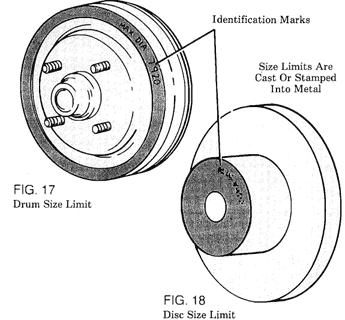Brake Rotor
Brake Drum
How thin can rotor drums be safely turned

If a customer wants drums turned to a size outside the
limits cast into the drum, you must refuse. They cannot be
turned thinner than the minimum thickness specifications
stamped or cast on the rotor or drum itself. A drum or rotor
worn or turned too thin may not be able to absorb and
dissipate heat quickly.
This can make the brakes run hot, accelerate lining wear,
and reduce braking effectiveness. It can also lead to rotor
or drum warpage and a pulsating brake pedal.
Most drums are cast with enough thickness to allow 0.090" of
wear. In other words, the difference between a drum's
diameter when new and its discard diameter is 0.090," but
that doesn't mean you can machine a drum right up to the
0.090" limit. You should never turn a drum that's worn more
than 0.060" beyond its original diameter.
The 0.060" limit leaves a 0.030" margin for additional wear.
If you turn a drum that's worn more than 0.060," or if the
drum ends up being more than 0.060" larger after turning,
there may not be enough metal left to handle normal wear
until the next brake job.
The 0.090" discard limit is the maximum acceptable wear the
drum can safely handle before the metal is too thin. Any
drum worn beyond 0.060", or that would be over 0.060" larger
after resurfacing, should never be turned on a lathe, it
should be replaced.
Wear is checked by measuring diameter with a drum
micrometer. If the gauge shows enough metal left to safely
turn it, the drum can be resurfaced to restore and true the
surface.
Like drums, the amount of wear a rotor has experienced will
determine whether or not it can be resurfaced. The two-key
rotor dimensions to take into account are minimum refinish
thickness and discard thickness.
Discard thickness is usually cast in the rotor itself, but
minimum refinish thickness must often be looked up in a
reference manual or brake specification chart.
Minimum refinish thickness is the limit for resurfacing the
rotor. If the rotor has worn to the point where its
thickness will be less than the specified dimension after
resurfacing, the rotor should be replaced.
Discard thickness is the maximum acceptable wear limit. Once
the rotor is worn beyond discard thickness, it must be
replaced. The difference between discard and minimum
refinish thickness is the margin the vehicle manufacturer
believes is necessary to allow for normal wear between brake
jobs. It varies considerably from one vehicle manufacturer
to the next, and according to vehicle size and type of
brakes used.
The margin specified on most domestic passenger cars is
around 0.015." The range is 0.020" to 0.030" for most
imports. A few, such as Jaguar, have as much as a 0.050"
difference between minimum refinish thickness and discard
thickness.
Thickness should be measured with a micrometer at six evenly
spaced points around the rotor. The smallest measurement
should be used since this is how far the rotor will have to
be machined to restore the surface.
Measuring at various points around the rotor will reveal any
variations in rotor thickness or parallelism. Both surfaces
of the rotor must be within the manufacturer's specified
tolerances for parallelism, otherwise the rotor can cause
excessive pedal travel (by kicking the pads too far out as
it turns), front end vibration, pedal pulsation, and
chatter.
Parallelism specs recommended by various vehicle
manufacturers range from as low as 0.0001" to as high as
0.0008." Refer to reference charts to determine how much
correction, if any, is needed.
Another critical rotor dimension is runout. Lateral runout
is the movement of the rotor from side to side as it turns.
Excessive runout will kick the pads out as the rotor turns,
creating excessive clearance requiring increased pedal
travel when brakes are applied.
Runout specifications vary from as low as 0.002" to as high
as 0.006." You should always refer to the particular specs
listed by the vehicle manufacturer when checking runout.
Runout is checked with a dial indicator while the rotor is
still on the car. If run-out exceeds the recommended limit,
the rotor must be resurfaced or replaced.
Drums and rotors should always be inspected for heat cracks,
distortion, damage, and hard spots prior to resurfacing.
Cracks, damage and hard spots call for replacement. If
distortion can't be eliminated within the limits of
resurfacing, replacement will also be necessary.
OneStop Auto Shop
Call Today for
all of your Auto Repairs
and Maintenance
in Hollywood, Ca.!
(323) 227-9999
|























